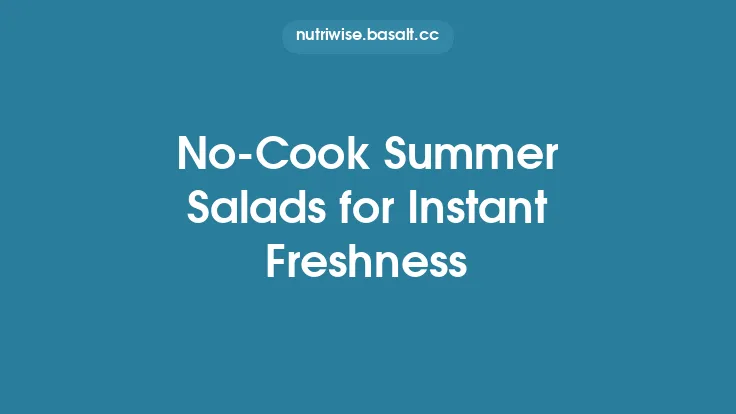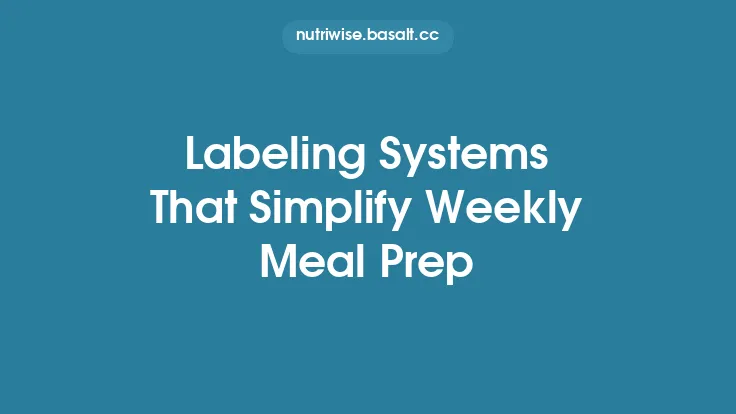When you’re juggling a busy workweek, the idea of pulling together a fresh, satisfying lunch every day can feel overwhelming—especially if you need to keep gluten out of the picture. The good news is that with a little planning, a handful of versatile ingredients, and some smart storage tricks, you can build a pantry of meal‑prep‑ready lunches that stay fresh, taste great, and keep you energized from morning until evening.
Why Gluten‑Free Meal Prep Works
Gluten‑free cooking often relies on whole foods—vegetables, lean proteins, legumes, nuts, seeds, and naturally gluten‑free grains. These ingredients are inherently stable and, when paired with proper storage, can maintain texture and flavor for several days. Additionally, many gluten‑free staples (e.g., quinoa, brown rice, lentils) have a longer shelf life than processed wheat‑based products, reducing waste and saving money.
Key benefits include:
- Consistent nutrition – You control macronutrient ratios and micronutrient variety.
- Time efficiency – Batch‑cooking once or twice a week eliminates daily cooking.
- Reduced cross‑contamination risk – Preparing meals in a dedicated gluten‑free zone minimizes accidental exposure.
- Cost control – Bulk‑buying staples and using seasonal produce keeps the budget in check.
Core Components of a Balanced Gluten‑Free Lunch
A well‑rounded lunch should hit three nutritional pillars:
- Protein – Keeps you full and supports muscle repair. Options: grilled chicken breast, turkey mince, canned tuna, tempeh (if soy is tolerated), hard‑boiled eggs, or plant‑based proteins like lentils and chickpeas.
- Complex Carbohydrate – Supplies steady energy. Gluten‑free grains (quinoa, millet, sorghum), starchy vegetables (sweet potatoes, butternut squash), and legumes fit the bill.
- Fiber‑Rich Vegetables – Add volume, vitamins, minerals, and antioxidants. Aim for a colorful mix: leafy greens, bell peppers, carrots, broccoli, zucchini, and roasted root vegetables.
A typical portion ratio for a 500‑600 kcal lunch is:
- Protein: 3–4 oz (≈85–115 g)
- Carbs: ½–¾ cup cooked grain or starchy veg
- Veggies: 1–1½ cups (raw or cooked)
Choosing the Right Gluten‑Free Grains for Longevity
Not all gluten‑free grains behave the same in the fridge. Here’s a quick guide to the most storage‑friendly options:
| Grain | Cooking Time | Shelf Life (refrigerated) | Texture After 4‑5 Days |
|---|---|---|---|
| Quinoa | 12‑15 min | 4–5 days | Fluffy, retains bite |
| Brown rice | 20‑25 min | 4–5 days | Slightly softer but still distinct |
| Millet | 15‑20 min | 4–5 days | Light, slightly chewy |
| Sorghum (pearled) | 25‑30 min | 4–5 days | Firm, grainy |
| Buckwheat (raw) – *use only if tolerated* | 10‑12 min | 4–5 days | Soft, slightly nutty |
Tip: Rinse grains thoroughly before cooking to remove excess starch, which can cause sogginess during storage.
Mastering the “One‑Pan” Method for Minimal Cleanup
Cooking everything on a single sheet pan or large roasting dish not only speeds up prep but also reduces the number of dishes you need to wash. Here’s a step‑by‑step workflow:
- Preheat the oven to 400 °F (200 °C). This temperature is ideal for caramelizing vegetables while keeping proteins moist.
- Arrange proteins on one side of the pan. Lightly coat with olive oil, salt, pepper, and any gluten‑free spice blend (e.g., smoked paprika, cumin, garlic powder).
- Add vegetables on the opposite side, tossing them in a separate drizzle of oil and seasoning.
- Insert a small ramekin with a splash of broth or water to create steam, preventing the veggies from drying out.
- Roast for 20‑30 minutes, flipping halfway through. Use a meat thermometer to ensure proteins reach safe internal temperatures (165 °F/74 °C for poultry, 145 °F/63 °C for pork and fish).
The result is a cohesive, flavor‑infused meal that stores beautifully in airtight containers.
Storage Strategies That Keep Lunches Fresh
1. Choose the Right Container
- Glass containers (e.g., Pyrex, Mason jars) are non‑reactive and preserve flavor better than some plastics.
- Compartmentalized bento boxes help keep sauces separate from dry components, preventing sogginess.
- Portion‑size lids (e.g., 500 ml) make it easy to grab a single serving without reheating the entire batch.
2. Cool Before Sealing
Hot food creates condensation, which accelerates spoilage. Spread cooked grains and proteins on a baking sheet to cool for 10‑15 minutes before transferring to containers.
3. Use a “Dry‑Wet” Layer System
- Bottom layer: Starchy base (rice, quinoa, sweet potato cubes).
- Middle layer: Protein (chicken, beans, tofu).
- Top layer: Fresh or lightly roasted vegetables.
- Separate sauce compartment: Store dressings, pesto, or vinaigrette in a small, leak‑proof container. Add just before eating.
4. Label with Dates
A simple marker or label with the prep date helps you rotate meals and avoid eating past the safe window (generally 4‑5 days for cooked meals in the fridge).
5. Reheat Smartly
- Microwave: Cover with a damp paper towel to retain moisture.
- Stovetop: Add a splash of broth or water to a skillet, cover, and heat gently.
- Cold‑ready options: Salads with pre‑cooked proteins can be eaten straight from the fridge, preserving texture.
Five Evergreen Gluten‑Free Lunch Recipes That Stay Fresh
Below are five adaptable recipes that meet the storage criteria above. Feel free to swap proteins, veggies, or seasonings to suit your palate.
1. Mediterranean Quinoa Power Bowls
Ingredients (makes 4 servings)
- 1 cup quinoa, rinsed
- 2 cups water or low‑sodium vegetable broth
- 1 lb (≈450 g) skinless chicken thighs, trimmed and cubed
- 1 red bell pepper, diced
- 1 cucumber, seeded and sliced
- ½ cup Kalamata olives, halved (ensure no added wheat‑based brine)
- ¼ cup crumbled feta (optional, if dairy is tolerated)
- 2 tbsp olive oil
- 1 tsp dried oregano
- Salt & pepper to taste
Dressing (store separately)
- 3 tbsp extra‑virgin olive oil
- 2 tbsp lemon juice
- 1 tsp Dijon mustard (check label for gluten‑free)
- 1 clove garlic, minced
- Pinch of salt
Method
- Cook quinoa in broth; bring to a boil, reduce heat, cover, simmer 15 min. Fluff and let cool.
- Toss chicken cubes with olive oil, oregano, salt, and pepper. Roast on a sheet pan at 400 °F for 20 min, turning halfway.
- Assemble bowls: quinoa base, roasted chicken, raw bell pepper, cucumber, olives, and feta.
- Store dressing in a small container; drizzle before eating.
Shelf life: 4 days refrigerated; quinoa and chicken stay firm, veggies stay crisp if kept dry.
2. Sweet Potato & Black Bean Harvest Bowl
Ingredients (makes 5 servings)
- 2 large sweet potatoes, peeled and cubed (≈3 cups)
- 1 can (15 oz) black beans, drained, rinsed
- 1 lb (≈450 g) ground turkey, seasoned with cumin, smoked paprika, and chili powder (gluten‑free)
- 1 red onion, sliced
- 2 tbsp avocado oil
- ½ cup chopped cilantro (optional)
Sauce (store separately)
- ¼ cup tahini
- 2 tbsp lime juice
- 1 tbsp maple syrup
- Warm water to thin
Method
- Toss sweet potato cubes and onion with avocado oil, salt, and pepper. Roast 25 min at 425 °F, stirring halfway.
- While veg roast, brown ground turkey in a skillet; add spices and cook through.
- Mix roasted sweet potatoes, turkey, and black beans in a large bowl.
- Portion into containers; keep sauce in a small jar.
Shelf life: 5 days; sweet potatoes retain a pleasant bite, and the beans stay moist.
3. Asian‑Inspired Buckwheat (Soba) Free Noodle Salad
> Note: Use 100 % buckwheat noodles that are certified gluten‑free, or substitute with rice vermicelli if buckwheat is a concern.
Ingredients (makes 4 servings)
- 8 oz gluten‑free buckwheat noodles (or rice vermicelli)
- 1 lb (≈450 g) shrimp, peeled and deveined
- 1 cup shredded red cabbage
- 1 cup julienned carrots
- ½ cup edamame (shelled)
- 2 tbsp sesame oil
- 1 tsp grated ginger
- 2 tbsp gluten‑free soy sauce or tamari
- 1 tbsp rice vinegar
- 1 tsp honey (optional)
- Sesame seeds for garnish
Method
- Cook noodles according to package; rinse under cold water, drain, and toss with a drizzle of sesame oil.
- Sauté shrimp with ginger in a hot pan for 2‑3 min per side; set aside.
- In a large bowl, combine noodles, cabbage, carrots, edamame, and shrimp.
- Whisk soy sauce, rice vinegar, honey, and remaining sesame oil; pour over salad and toss.
- Portion; sprinkle sesame seeds just before serving.
Shelf life: 3 days (shrimp is the limiting factor). Keep salad chilled and add fresh herbs at the point of consumption.
4. Lentil & Roasted Veggie Sheet‑Pan Meal
Ingredients (makes 6 servings)
- 1 ½ cups dry green or brown lentils, rinsed
- 3 cups water or low‑sodium broth
- 1 lb (≈450 g) firm tofu, pressed and cubed (if soy is tolerated) – otherwise use cubed tempeh or extra lentils
- 2 cups Brussels sprouts, halved
- 1 cup cherry tomatoes, halved
- 1 cup diced carrots
- 2 tbsp olive oil
- 1 tsp smoked paprika
- 1 tsp dried thyme
- Salt & pepper
Method
- Cook lentils: bring water/broth to boil, add lentils, simmer 20‑25 min until tender but not mushy. Drain excess liquid.
- Toss tofu (or tempeh) and vegetables with olive oil, smoked paprika, thyme, salt, and pepper. Spread on a sheet pan.
- Roast at 425 °F for 20‑25 min, turning halfway.
- Combine roasted mixture with cooked lentils; portion into containers.
Shelf life: 5 days; lentils hold texture well, and roasted veggies stay flavorful.
5. Cold Chickpea & Avocado Wraps (Gluten‑Free Tortilla)
Ingredients (makes 4 wraps)
- 4 gluten‑free whole‑grain tortillas (check for 100 % gluten‑free certification)
- 1 can (15 oz) chickpeas, drained, rinsed, and lightly mashed
- 1 ripe avocado, diced
- ¼ cup diced red onion
- 1 tbsp fresh lime juice
- 1 tsp cumin
- Salt & pepper
- Handful of baby spinach or arugula
Method
- In a bowl, combine mashed chickpeas, avocado, red onion, lime juice, cumin, salt, and pepper. Mix gently to keep some texture.
- Lay a tortilla flat, layer with spinach, then spoon chickpea‑avocado mixture down the center.
- Roll tightly, slice in half, and wrap each in parchment paper for easy transport.
Shelf life: 2 days (avocado oxidizes quickly). To extend freshness, keep the avocado mixture in a separate container and assemble the wrap just before lunch.
Nutrient Timing & Portion Control for Sustained Energy
- Carb‑Protein Pairing: Pairing a moderate amount of carbs with protein slows glucose absorption, preventing mid‑day energy crashes.
- Fiber Boost: Aim for at least 5 g of fiber per lunch. Add a sprinkle of chia seeds, a handful of nuts, or extra veggies.
- Healthy Fats: A tablespoon of olive oil, a quarter avocado, or a few nuts provide satiety without excess calories.
If you’re active or have higher caloric needs, increase the grain portion by ¼ cup and add an extra protein serving (e.g., a boiled egg or a scoop of Greek‑style dairy‑free yogurt).
Food‑Safety Checklist for Gluten‑Free Meal Prep
| Step | What to Do | Why It Matters |
|---|---|---|
| Clean | Sanitize countertops, cutting boards, and knives before starting. | Reduces cross‑contamination from hidden gluten sources. |
| Separate | Use dedicated gluten‑free containers and utensils. | Prevents accidental gluten transfer. |
| Cool Quickly | Divide hot foods into shallow containers; refrigerate within 2 hours. | Limits bacterial growth (danger zone 40‑140 °F). |
| Label | Write prep date and contents on each container. | Helps track freshness and avoid spoilage. |
| Reheat | Heat leftovers to an internal temperature of 165 °F (74 °C). | Ensures any potential pathogens are destroyed. |
| Inspect | Before eating, check for off‑odors, slime, or discoloration. | Early detection of spoilage prevents foodborne illness. |
Adapting Meals for Seasonal Variations
Seasonal produce not only tastes better but also keeps costs down. Here’s a quick guide to swapping ingredients without compromising the gluten‑free integrity:
| Season | Suggested Swaps |
|---|---|
| Spring | Replace roasted carrots with asparagus; use peas instead of edamame. |
| Summer | Swap sweet potatoes for grilled corn kernels; add fresh tomatoes and basil. |
| Fall | Use butternut squash in place of sweet potatoes; incorporate roasted apples for a subtle sweetness. |
| Winter | Add kale or collard greens; use parsnips and turnips as root‑veggie alternatives. |
When swapping, keep the cooking method consistent (e.g., roasting, steaming) to maintain texture and shelf life.
Quick Tips to Keep Lunches “Fresh‑Feeling”
- Add a splash of citrus (lemon, lime) just before eating to brighten flavors that may dull after a few days.
- Use a small ice pack in your lunch bag if you won’t have refrigeration until lunchtime.
- Incorporate crunchy elements (nuts, seeds, crisp veggies) in a separate compartment; add them right before you eat to avoid sogginess.
- Rotate sauces weekly—one week a tahini‑lime dressing, the next a herb‑y yogurt sauce (dairy‑free if needed). Variety prevents palate fatigue.
- Invest in a good quality vacuum sealer for longer storage; vacuum‑sealed meals can stay fresh up to 7 days in the fridge.
Final Thoughts
Meal‑prepping gluten‑free lunches that stay fresh is less about exotic ingredients and more about mastering a few core principles: balanced macronutrients, smart storage, and thoughtful seasoning. By building a repertoire of versatile base components—quinoa, lentils, roasted vegetables, and reliable proteins—you can mix and match to create dozens of satisfying lunches that keep you nourished and confident throughout the workweek.
Remember to:
- Plan your menu at the start of each week.
- Batch‑cook grains and proteins on the same day.
- Cool, portion, and label promptly.
- Refresh with a quick squeeze of lemon, a sprinkle of herbs, or a dash of sauce right before you dig in.
With these strategies in place, you’ll find that gluten‑free meal prep isn’t a chore—it’s a sustainable habit that supports your health, saves time, and makes lunchtime something to look forward to. Happy prepping!





